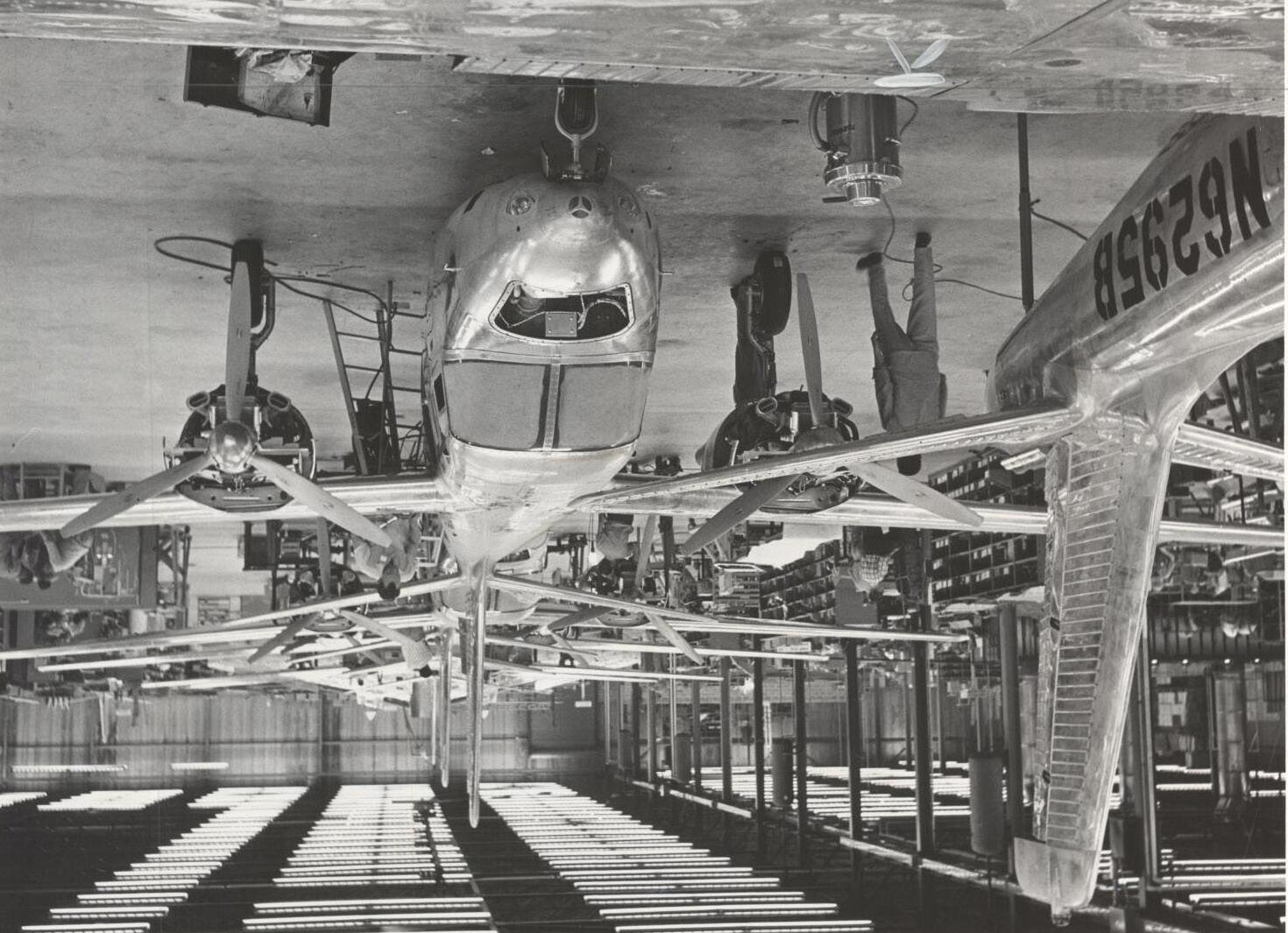
OKPOP




The OKPOP Foundation, which is fundraising $18 million for Phase 2 of the Oklahoma Museum of Pop Culture, announced almost $8.6 million in private funding contributions to date.
“Leveraging the dollar-for-dollar state match, we have been quietly fundraising for Phase 2 of this museum,” said Abby Kurin, managing director of the OKPOP Foundation, during opening remarks. “And we’ve been in a silent campaign phase long enough. We are here to take this campaign public. We are beyond pleased and proud to report that we are 48 percent toward reaching our private match goal of $18 million.”
Lt. Gov. Matt Pinnell and Tulsa Mayor G. T. Bynum, both members of the OKPOP Campaign Cabinet, spoke to the standing-room-only crowd, celebrating the progress, anticipating the museum’s economic and community impact once it opens, and encouraging support for fundraising efforts.
“Our group has a year to raise the money,” said Pinnell. “It shouldn’t just be Tulsa: it should be northeastern Oklahoma, it should be statewide, it should be 77-county support.”
Oklahoma legislators set aside an $18 million dollar match for OKPOP in 2023, and in July 2024, Governor Kevin Stitt signed SB1155, solidifying the match that set a fundraising deadline of November 2025. Key donors recognized during the event for significant contributions to the $8.6 million raised to date included BOK Financial, the Chickasaw Nation, the Cherokee Nation, the George Kaiser Family Foundation, the Tulsa Community Foundation, the City of Tulsa, Ken and Jeanine Clifford, and Leigh and John Reaves.
When complete, the Heart and Soul Campaign will provide funding for designing and building interactive museum exhibits featuring hundreds of Oklahoma pop culture creatives and artifacts and additional acquisitions, museum operations, and marketing. OKPOP has acquired over 40,000 items, including instruments, puppets, playbills, costumes, sketches, and more. In addition, the OKPOP team has recorded nearly 700 video interviews with Oklahoma creatives.
“OKPOP is about preserving our legacy, celebrating our creativity, and creating inspirational and aspirational moments to empower the generations to come,” said Jake Krumwiede, OKPOP director. “We are a state that has produced incredible creativity from the stage to the screen to the recording studio…and everywhere in front of and behind the scenes. This museum is a celebration of those Oklahomans and their powerful stories. It’s great to be in a room full of people who believe in OKPOP as much as we do.”

“Music is my livelihood, and Oklahoma is my home— my heart. So, when I heard more about OKPOP’s mission to inspire and empower young Oklahoma musicians or artists like me, I knew I had to get involved. OKPOP is telling the stories of Oklahomans who influence pop culture in such a cool and innovative way, and folks from all over the country are going to love it.”
Blake Shelton, Honorary Campaign Chair

“OKPOP is about telling the stories of Oklahomans who brought our culture to the rest of the world. Cherokee Nation is a significant part of Oklahoma’s story, including our tribe’s most famous citizen, Will Rogers. We’re proud to be a part of the effort to complete this world-class museum and preserve the significant contributions of Oklahomans on the world stage.”
- Chuck Garrett, CEO of Cherokee Nation Businesses
“OKPOP is more than just a museum; it’s a cultural hub that enriches the lives of all Oklahomans. At BOK Financial, we’re committed to supporting initiatives that improve the quality of life for our employees and our customers. OKPOP embodies the spirit of Oklahoma, and we’re proud to be a part of it. We believe that investing in education and culture is an investment in our community’s future.”
- Stacy Kymes, CEO of BOK Financial
“Chickasaw Citizens have been artists and storytellers for generations; we believe wholeheartedly in the power of art and storytelling. The Chickasaw Nation supports the OKPOP Museum because, just as we showcase and celebrate the resilient and persevering spirit of the Chickasaw people, we believe OKPOP will both highlight and inspire artists from all across the state of Oklahoma.”
- Governor Bill Anoatubby, Chickasaw Nation
“As lifelong music lovers, we’re excited to support OKPOP. What is life without music or art or storytelling? This project celebrates the incredible musicians who have come from Oklahoma and continue to inspire us. OKPOP will be a place where people can connect with music, learn about our state’s musical history, and create their own music. I can’t wait to see what the future holds for OKPOP.”
- Ken and Jeanine Clifford
“As residents and business owners in the Tulsa Arts District, we’re thrilled to support OKPOP. This vibrant community is the perfect home for a project that celebrates Oklahoma’s rich cultural heritage. OKPOP will inspire future generations of artists, musicians, and creatives. We’re proud to be a part of this exciting initiative, and we can’t wait to see the positive impact it will have on our community.”
- Leigh and John Reaves
“As someone deeply rooted in Oklahoma, I’ve always believed in the power of arts and culture to inspire and transform. OKPOP embodies this spirit, and I’m honored to be a part of bringing this vision to life. This project will leave a lasting legacy for generations to come. Together, we’re creating something truly special.”
- Jeff Stava, Tulsa Community Foundation and GKFF


By authorization of the Oklahoma Historical Society (OHS) Board of Directors, 3,600 copies are prepared at a cost of $1,293.61 bimonthly. The publication is financed in part with federal funds from the National Park Service, United States Department of the Interior.
Contents and opinions do not necessarily reflect the views or policies of the Oklahoma Historical Society or the United States Department of the Interior. Mention of trade names does not constitute endorsement or recommendation by either organization.
Mistletoe Leaves is published for the members and friends of the OHS in partial fulfillment of its mission to collect, preserve, and share the history and culture of the state of Oklahoma and its people.
Students and teachers are invited to share studies and programs and to duplicate content as desired. Editors are welcome to reprint materials with credit.
All Oklahoma Historical Society facilities are for the education and enjoyment of all. State and federal regulations prohibit unlawful discrimination in state and federally-assisted programs on the basis of race, color, national origin, and/or handicap.
Anyone denied benefits should contact the grievance manager of the Oklahoma Historical Society, 800 Nazih Zuhdi Drive, Oklahoma City, OK 73105-7917, telephone 405-837-7631 and/or the director, Office of Equal Opportunity, United States Department of the Interior, Washington, DC 20240.
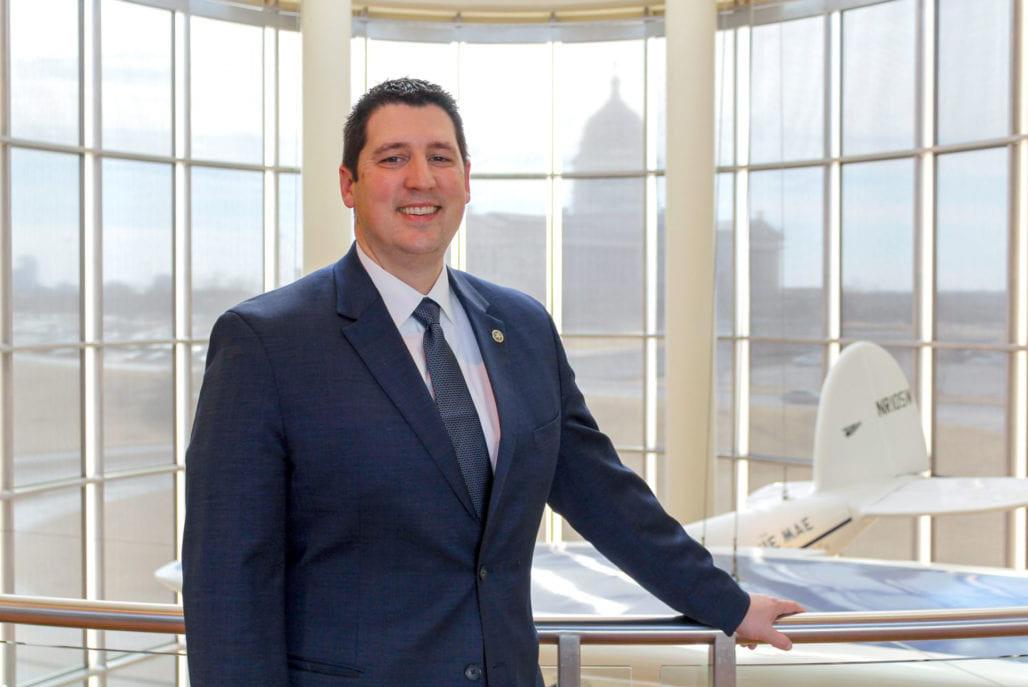
By Trait Thompson
Last year, the Oklahoma Historical Society hosted over 300 events across the state. These events included everything from exhibit openings and living history programs to lectures and conferences. We always strive to reach the broadest audience by presenting Oklahoma’s unique and fascinating history in a variety of formats. Whether young or old, we want our patrons to be engaged, excited, and entertained by the stories that make up our shared past. 2024 gave us unique opportunities to create programming at our museums and historic sites. The pathway for the full solar eclipse allowed us to combine history with science and host a watch party at historic Fort Towson in April. Later that month, we commemorated the 200th anniversary of the establishment of Fort Gibson and Fort Towson with living history demonstrations about civilian and military life in and around both forts. In the summer, staff from the Oklahoma Archaeological Survey and University of Oklahoma students spent two weeks excavating at the Spiro Mounds archaeological site. Along the way, we celebrated the 50th anniversary of the Museum of the Western Prairie in Altus and the Oklahoma Territorial Museum in Guthrie.
Undoubtedly, 2024 was a great year at the OHS, and we have plans for an even better one in 2025. Here are a few of the things we are working on:
In March, the OHS Awards Banquet will be back, and we will be inducting new members into the Oklahoma Historians Hall of Fame and giving awards for the outstanding book on Oklahoma history, the outstanding student historian, and many others. This event allows us to honor those who have contributed to our expanding knowledge of Oklahoma history, and I hope you’ll plan to join us.
In April, the Oklahoma History Center will commemorate the 100th anniversary of the adoption of the Oklahoma flag. The current flag, with the Osage shield on a blue field, was designed by Louise Fluke and submitted in a contest hosted by the Daughters of the American Revolution. It replaced the previous design, which was a field of red with a single white star at its center. The number 46 was centered inside the star motif.
November will undoubtedly be a busy month for our staff. Once again, we will host the biannual Civil War demonstrations at Honey Springs Battlefield. Visitors will have the opportunity to see live battles with reenactors and learn more about the animals, equipment, and firearms used in Civil War battles in Indian Territory. Later that month, we will be hosting a banquet to celebrate the 20th anniversary of the Oklahoma History Center. It’s hard to believe our flagship building is already two decades old!
These events are in addition to many others throughout the state you’ve come to know and love. You don’t want to miss the Chuck Wagon Gathering at The Chisholm in Kingfisher, the History Symposium in Oklahoma City, the Wild West Show at Pawnee Bill Ranch, and hundreds of other fun and engaging activities. I hope you’ll keep an eye on our website’s calendar section and participate in all we have planned for 2025!

Ada Lois Sipuel Fisher was born in Chickasha on February 8, 1924. While attending Langston University in the 1940s, she dreamed of becoming a lawyer. On January 14, 1946, Fisher applied to the University of Oklahoma College of Law. At the time, Oklahoma statutes prohibited whites and Blacks from attending classes together. Fisher was an important Civil Rights Movement activist who challenged Oklahoma’s seg regation laws. After a three-year legal battle, a US Supreme Court ruling, and continued inequity, Fisher was finally ad mitted to law school at the University of Oklahoma in 1949. She graduated from the OU College of Law in 1952, paving the way for future generations.

This year, we are taking you behind the scenes to learn more about the steps our Research staff go through to process historic items donated to the Oklahoma Historical Society (OHS).
The OHS Manuscript Archives include paper items created by businesses or individuals. Some collections contain documents of a personal nature, while others originated with a specific business or industry. The items are letters, diaries, scrapbooks, personal memoirs, biographies, business records and ledgers, research for books and articles, and drafts of books and articles. The collection at OHS also consists of ephemera such as advertisements, brochures for events or organizations, and travel memorabilia. Oversize collections include architectural renderings and plans, maps, posters, and certificates. The archives contain more than 2,500 collections ranging in size from one item to seventy-five boxes or more. Spanning more than one thousand linear feet of shelf space, the collection contains nearly one million pages!
In every case, it is the daily work of Research archivists to determine how to convert these items from donations to digital forms that the public can share and use, which goes directly to the heart of OHS’s mission to collect, preserve, and share the history and culture of the state.
First, we collect donations and begin the process of housing, cataloging, and describing the items. Every donation goes through a gentle triage to determine if documents or manuscripts are in fragile condition, whether copyrights may apply, or if there could be privacy issues surrounding items donated. Also, in some cases, determinations are made to judge other concerns, including if the items donated may have sensitive cultural materials.
Next, the items go through a process of digitization. For smaller records, each document is individually scanned by Epson flatbed scanners that can capture up to 11 x 14 inches. For oversized materials, a larger scanning bed is used, and an overhead camera can capture bound volumes.
The OHS works in partnership with the University of North Texas (UNT). Our agreement with this institution provides a natural exchange for OHS Research staff to use UNT’s state-of-the-art technology while having the assurance of working with an institution that follows similar rigorous standards. Before UNT receives batches of records, OHS creates folders with unique names. OHS staff and
On Tuesday, January 28, the Cherokee Strip Historical Society (CSHS) will hold its annual meeting and dinner, followed by a program about Buster Keaton (1895–1966). The primary focus of the CSHS is the growth and development of the Cherokee Strip Museum.
The Buster Keaton program will be free and open to the public. It will take place at 6:45 p.m. at the Heritage Center, located at 222 North 6th Street in Perry.
OETA producer, documentary writer, and reporter Robert Burch will lead a discussion about Buster Keaton’s connections to the state. This will include stories about his father’s involvement in the Cherokee Outlet Opening of 1893, his friendship with Will Rogers, connections to Harry Houdini, and his later career in vaudeville and filmmaking in New York. Keaton began performing on stage with his parents in a traveling act when he was just three years old. His signature physical comedy and remarkable stunt work ultimately led to his fame. The program will also feature clips from Keaton’s wellknown silent films. At the end of the evening, there will be a brief membership drive in the Heritage Center lobby.
volunteers ensure they provide a straightforward description for in dividual items. Each collection also needs a written narrative prepared to characterize each type of col lection and the people who donat ed the items. This way, when the scanned images arrive at UNT, they can be easily organized and uploaded to the digital portal.
Anyone who has ever experienced the organization of family photos can understand the monumental task our Research staff faces in adding descriptive information to each item. The most time-consuming part of preparing manuscripts is likely when the required metadata includes titles, creators, dates, descriptions, and subjects. The only way to discern this information is to read through the records of each item to analyze and define the descriptive contents carefully.


The last step of the process is the rewarding goal of making our manuscripts available to the public. All of the steps that lead up to digitization of historic documents take a good deal of time. Making records available to the public can take months and depend on staff availability and time.
Priority is given to starting with the most used and fragile collections because there is an immediate need to protect the actual items by capturing a scan. Following best practices and standards recommended by the National Archives, the actual item can be safely stored while the digital copy is studied and shared.
Visit gateway.okhistory.org any time of the day or night to search through manuscripts, newspapers, and photographs online.

“An Afternoon with General James Gilpatrick Blunt”
On Saturday, February 15, from 1 to 2 p.m., Honey Springs Battlefield will host living historian Jim Spillars, who will portray Major General James Gilpatrick Blunt (1826–1881). Spillars will give a presentation on Blunt’s leadership during the Engagement at Honey Springs which was the largest of more than 107 documented hostile encounters in Indian Territory. He will be dressed in period Civil War attire for this event.
James Gilpatrick Blunt was a ship captain, a physician, and an abolitionist. He led Indigenous and Black troops to victory at the Battle of Honey Springs, helping to bring a portion of Indian Territory under Union control.
Jim Spillars is the former president of the Washington County Historical Society and has dedicated many years to studying and portraying Major General Blunt.

History Alive! on the Cherokee Strip, Cherokee Strip Regional Heritage Center, Enid
Quilting Workshop, Sod House Museum, Aline
Oklahoma Historical Society Executive Committee Meeting, Oklahoma History Center, Oklahoma City
Historic Preservation Review Committee Meeting, Oklahoma History Center, Oklahoma City
History Alive! on the Cherokee Strip, Cherokee Strip Regional Heritage Center, Enid
Lunch and Learn: “Care Before It’s Gone” (unveiling the new SHPO State Plan) webinar, State Historic Preservation Office
Oklahoma Historical Society Board of Directors Quarterly Meeting, Oklahoma History Center, Oklahoma City
Into the Mirror exhibit closes, Oklahoma History Center, Oklahoma City
Treblinka: Hitler’s Killing Machine Smithsonian film screening and discussion panel, Oklahoma History Center, Oklahoma City
Cherokee Strip Historical Society Annual Meeting and Buster Keaton presentation with OETA’s Robert Burch, Heritage Center, Perry
Movie Night at Will Rogers
Claremore
Please visit okhistory.org/events for additional information about OHS events and programs.
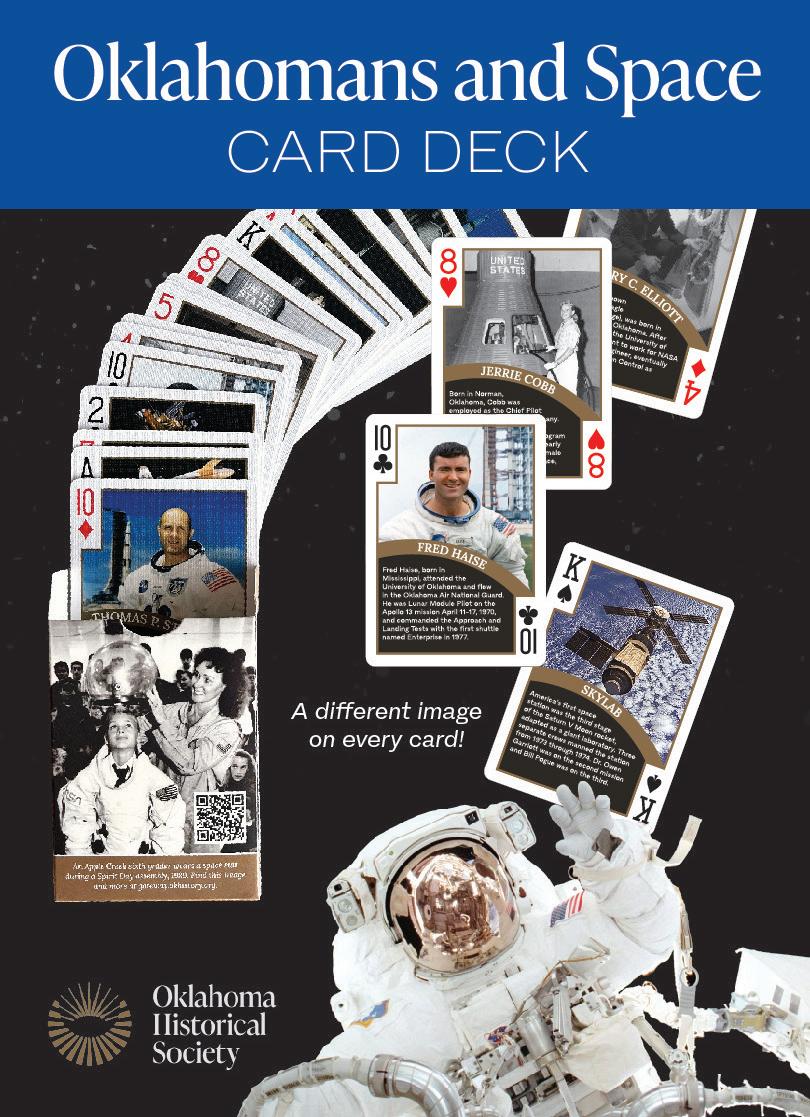

Antique Doll exhibit opens, Fred and Addie Drummond Home, Hominy
History Alive! on the Cherokee Strip, Cherokee Strip Regional Heritage Center, Enid
Quilting Workshop, Sod House Museum, Aline
A Life on Fire: Oklahoma’s Kate Barnard author talk with Connie Cronley, Oklahoma Territorial Museum and Carnegie Library, Guthrie
History Alive! on the Cherokee Strip, Cherokee Strip Regional Heritage Center, Enid
“An Afternoon with General Blunt” presentation with Jim Spillars, Honey Springs Battlefield, Checotah
Oklahoma Route 66 Centennial Commission meeting, Oklahoma History Center, Oklahoma City
Lunch and Learn: “Finding your Native Roots with the Dawes Rolls” with Laura Martin webinar, State Historic Preservation Office
Oklahoma Historical Society Executive Committee Meeting, Oklahoma History Center, Oklahoma City
“Our Museum” Oklahoma History Center Museum Open House, Oklahoma City
The Green Book: Guide to Freedom Smithsonian film screening and discussion panel, Oklahoma History Center, Oklahoma City
Kilgen Theatre Organ Performance with Juan Cardona Jr. and Silent Movie (1976), Oklahoma History Center, Oklahoma City
Dawes Commission in Cherokee Nation: Freedmen Exhibit closes, Fort Gibson Historic Site, Fort Gibson
Antique Doll exhibit closes, Fred and Addie Drummond Home, Hominy
Movie Night at Will Rogers Memorial Museum, Claremore
On Monday, February 24, from 7 to 8:30 p.m., a Kilgen Theatre Organ performance will take place in the Devon Great Hall at the Oklahoma History Center (OHC). The performance will feature Juan Cardona, Jr., who will accompany the Mel Brooks film Silent Movie (1976).
To purchase tickets for Kilgen Theatre Organ events, visit okhistory.org/tickets or call 405-522-0765.
On Monday, January 27, in observance of International Holocaust Remembrance Day, the Oklahoma History Center (OHC) will screen the Smithsonian film Treblinka: Hitler’s Killing Machine. This powerful documentary examines the history of the Treblinka extermination camp, one of the deadliest Nazi death camps during the Holocaust. Through survivor testimonies, archival footage, and expert analysis, the film details the systematic mass murder of over 800,000 Jews and other victims who were brutally killed in gas chambers.
A discussion will follow the screening to explore the film’s sobering content, the experiences of those who perished, and the few who managed to survive, shedding light on the horrific methods employed by the Nazis to carry out this genocide.
The screening and discussion will take place in the Musser Learning Lab on the first floor of the OHC and are intended for guests ages 18 and older. Call 405-522-0765 for more information.
The Pioneer Woman Museum and Statue will organize the second annual Oklahoma Women’s History Conference at the Oklahoma History Center on Saturday, March 1, from 10 a.m. to 4 p.m. The event is free to the public, but registration is required.
The first panel discussion will take place from 11 a.m. to 12:15 p.m. The topic is early Oklahoma women’s activism, and featured speakers are Edith Ritt-Coulter, Rilla Askew, and Connie Cronley. Fellow historian Sunu Kodumthara will moderate the panel.
During lunch, Autumn Brown of the Clara Luper Civil Rights and Freedom Center and the Oklahoma State University Archive’s Oklahoma Women’s Resources will give a keynote presentation from 12:30 to 1:30 p.m. Lunch will be followed by another panel discussion from 1:45 to 3 p.m., featuring members of the Oklahoma Commission on the Status of Women and the Oklahoma Women’s Hall of Fame. Saidy Herrera, the Oklahoma Historical Society multicultural officer, will moderate this panel.
A social hour will be held from 3 to 4 p.m. to promote networking opportunities for attendees. In addition to panels, the event will host a pop-up area with local nonprofit women’s organizations to share information and resources.
The Pioneer Woman Museum and Statue staff organize this annual conference. For more information, please call 580-765-6108.
A grand celebration to reopen the historic Fort Gibson Hospital, originally built in the 1870s, took place last November. During the event, exhibits highlighting historical medical practices were unveiled in the newly restored building.
After many years of extensive repairs and the dedicated efforts of the Oklahoma Historical Society’s construction staff, the 1870s hospital is now open to the public. It will serve as Fort Gibson’s new gift shop and includes orientation areas, gallery spaces, site maps, and a replica ward.
Originally constructed in the 1870s for $12,000, the hospital featured offices, a dispensary, a surgery room, and a ward with 12 beds. The building was designed with airy verandas encircling it, providing a recovery space for patients. In later years, the hospital’s location made it an ideal weather observation station for the Signal Service, offering commanding views for miles. While weather observations from the top of the building are no longer conducted, visitors can still enjoy the spectacular sights from the covered porches and the open ward.
The hospital, now the center of operations for the site, is located at 803 North Garrison Avenue, Fort Gibson.



Sculptor Paul R. Moore, a citizen of the Muscogee Nation, recently donated several small maquettes, small-scale sculptures, plaster casts, and reliefs to the Oklahoma Historical Society (OHS).
Moore is an award-winning artist who has sculpted more than 150 commissions for numerous municipal, corporate, private, and international collections. His bronzes are installed in the US Capitol Collection, the John F. Kennedy Presidential Library and Museum in Boston, MA, and the Smithsonian’s National Portrait Gallery in Washington, DC. In Oklahoma, Moore is perhaps best known for his Oklahoma Centennial Land Run Monument, installed at the south end of Bricktown in Oklahoma City and originally commissioned by the Centennial Committee.
Among the items donated to the OHS is his original bozzet—an initial outline for the monument conceived in clay. Other, more finished smallscale plaster figures, also a part of his collec tion, capture the primary forms and movement of the land run sculptures with more refinement. These pieces embody the seed of Moore’s ideas, ap proximating the positions of what eventually became a larger-than-life assembly of gestural pieces. The finished monument is 365 feet long and has 45 in dependent sculptures. Even in their raw, preliminary sketches, the small-scale models embody the spirit and determination of the men and women who par ticipated in Oklahoma’s five land runs. Moore and his sons completed the large-scale project in 2019.
He is currently an artist in residence at the Uni versity of Oklahoma School of Visual Arts in Norman, where his sculpture of the Seed Sower can be seen on the south oval of that campus.
While working with many large-scale works has taken a toll on his body, Moore continues teaching and sculpting smaller-scale projects with his same dedication. He contacted OHS when he began downsizing his studio space.
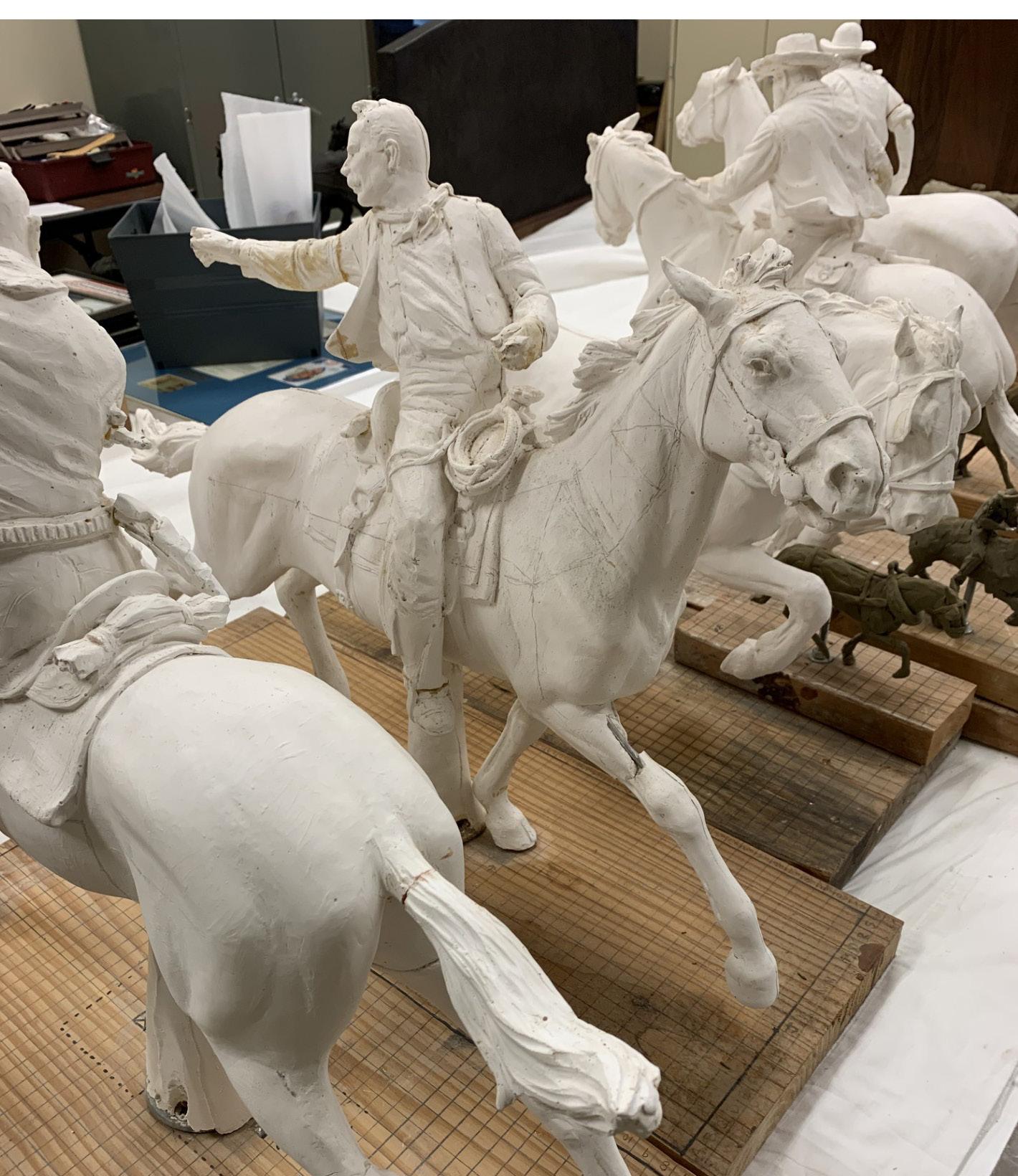
To find more information about Paul R. Moore’s life and work, visit his website, crownartsinc.com. This site features an online art gallery, collections, awards, past shows, and a list of publications.
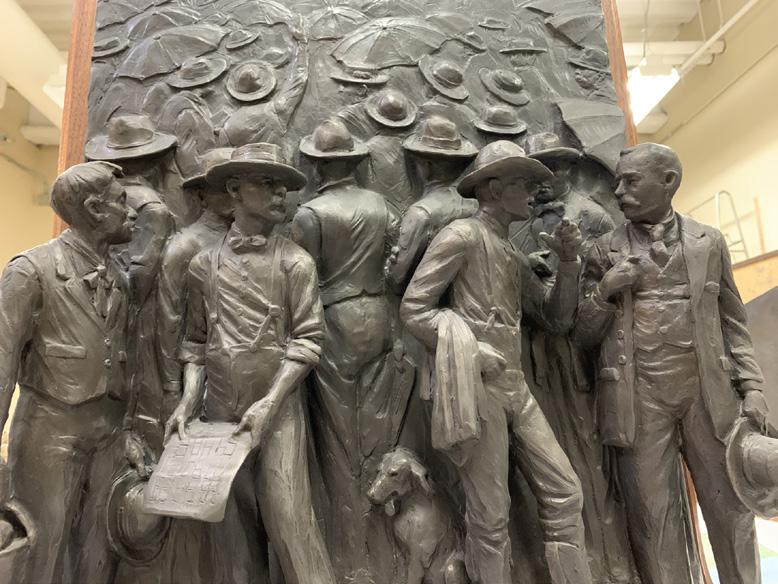
The Oklahoma Historical Society is excited to announce that the annual Awards Banquet will be held on Thursday, March 20, 2024, at 6 p.m. at the Oklahoma History Center. This special evening honors the remarkable work of historians, educators, students, and civic leaders who have made a meaningful impact on collecting, preserving, and sharing the history of Oklahoma and its people.
Among the awards presented, several distinguished historians will be inducted into the Oklahoma Historians Hall of Fame. These honorees are recognized for their lifelong commitment to preserving, interpreting, and promoting Oklahoma’s rich history.
The program will also feature the Guardian of History award, which celebrates elected officials who have played a significant role in safeguarding Oklahoma’s cultural heritage. Additional awards will recognize exceptional contributions from educators, students, writers, and community members who have gone above and beyond to ensure the preservation and understanding of our state’s past.
Details about ticket sales will be available soon. For information on sponsorship opportunities, please contact Brittney Berling, OHS development officer, at brittney.berling@history.ok.gov.

Before The Chronicles of Oklahoma, there was Historia. Published quarterly by curator William P. Campbell between 1909 and 1922, Historia was distributed free of charge to all Oklahoma Historical Society (OHS) members and donors. Non-OHS members could purchase an annual subscription for twenty-five cents. Historia’s primary purpose was to promote OHS collections. As historian Angie Debo writes, Historia featured
“descriptive lists of accessions, with personal data about the donors written in the friendly, breezy style of a small town newspaper.” This format was fitting giving Campbell’s background as a newspaperman, and Campbell used his personal finances to supplement any printing costs not covered by annual subscriptions.
The first issue of Historia, published on September 15, 1909, encompasses only four pages but provides a fascinating snapshot of the OHS, which was then only sixteen years old. The first page listed recent notable visitors, which included Father William H. Ketcham of the Bureau of Catholic Indian Missions, and acquisitions such as
The Oklahoma History Center Museum, a division of the Oklahoma Historical Society has again achieved accreditation by the American Alliance of Museums, the highest national recognition afforded to the nation’s museums. Accreditation signifies excellence to the museum community, to governments, funders, outside agencies, and the museum-going public. The Oklahoma History Center Museum has been accredited since 2014. All museums must undergo a reaccreditation review at least every 10 years to maintain accredited status. Alliance accreditation brings national recognition to a museum for its commitment to excellence, accountability, high professional standards, and continued institutional improvement. Developed and sustained by museum professionals for over fifty years, the Alliance’s museum accreditation program is the field’s primary vehicle for quality assurance, self-regulation, and public accountability. It strengthens the museum profession by promoting practices that enable leaders to make informed decisions, allocate resources wisely, and remain financially and ethically accountable to provide the best possible service to the public.
“The Oklahoma History Center Museum is proud to once again be recognized as an accredited institution by the American Alliance of Museums,” said Trait Thompson, executive director of the Oklahoma His-

the “remains of a mastodon whatsit” uncovered near Claremore. The second page featured folksy quips such as, “Texas may be a large state, but Woodward County has Mooreland,” while the final two pages listed almost 500 Oklahoma newspapers that regularly submitted issues for archiving. Subsequent issues expanded to as many as sixteen pages and included feature articles on a range of subjects. Regardless, Campbell always reserved print space to promote accessions to the OHS.
The Research Division recently completed scanning all available Historia issues. Visit okhistory.org/historia to learn more about an early publication dedicated to promoting and sharing Oklahoma history.
-Matthew Pearce, Ph.D.
torical Society. “This achievement reflects the dedication and hard work of our staff, volunteers, and leadership at the Oklahoma Historical Society. It affirms our commitment to excellence and underscores our mission to preserve and share Oklahoma’s history and culture. Accreditation ensures that we remain a trusted resource for our community, operating at the highest professional standards and on par with some of the nation’s most respected museums.”
Of the nation’s estimated 33,000 museums, roughly 1,100 are currently accredited. The Oklahoma History Center Museum is one of only 14 museums accredited in Oklahoma.
Accreditation is a very rigorous but highly rewarding process that examines all aspects of a museum’s operations. To earn accreditation, a museum must first conduct a year of self-study and then undergo a site visit by a team of peer reviewers. AAM’s Accreditation Commission, an independent and autonomous body of museum professionals, considers the self-study and visiting committee report to determine whether a museum should receive accreditation.
“Accreditation is a monumental achievement,” said AAM President and CEO Marilyn Jackson. “The process demonstrates an institution’s commitment to best practices and is flexible enough to be accomplished by museums of any size.”
The American Alliance of Museums (AAM) is the only organization representing the entire museum field, from art and history museums to science centers and zoos. Since 1906, it has championed museums through advocacy and provided museum professionals with the resources, knowledge, inspiration, and connections they need to move the field forward. For more information, visit aam-us.org
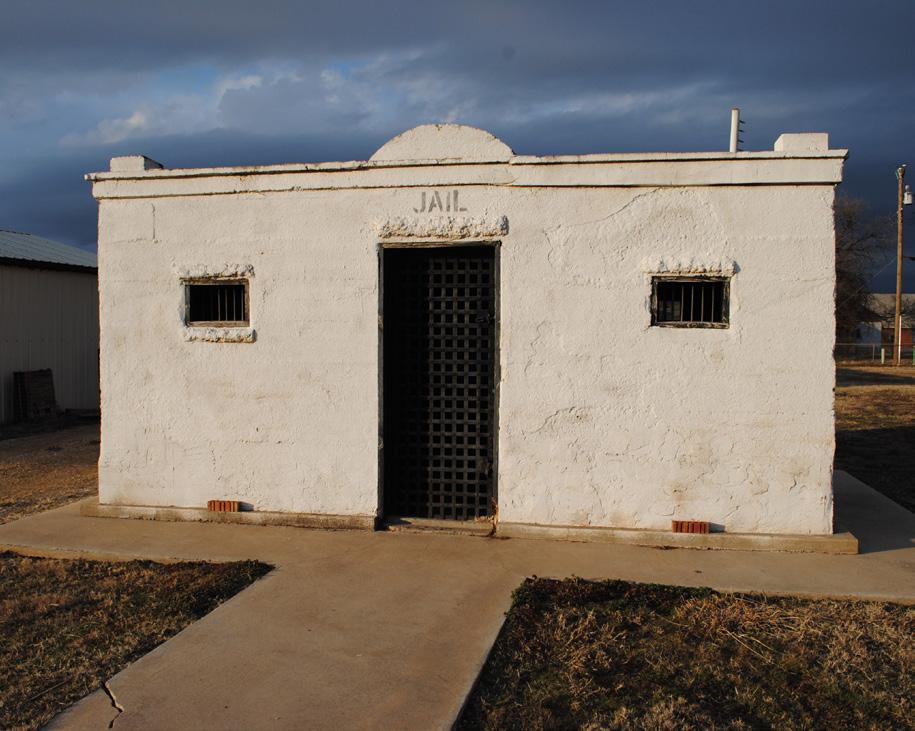
The Oklahoma Historical Society and State Historic Preservation Office (SHPO) are pleased to announce the National Register of Historic Places designation for the following property in Oklahoma. The National Register of Historic Places is our nation’s official list of properties significant in our past.
Constructed circa 1921, the Covington Jail is located at 514 West Main Street in Covington. It is significant as a free-standing, two-room jail built of formed concrete at the beginning of the 1920s in Oklahoma. Locally known as a “calaboose,” the Covington Jail is one of the last remaining buildings on Covington’s Main Street and is historically significant as an excellent example of Oklahoma’s early development of law.
Listing in the National Register of Historic Places is an honorific designation that provides recognition, limited protection and, in some cases, financial incentives for these important properties. The SHPO identifies, evaluates and nominates properties for this special designation.
The Oklahoma Historical Society’s State Historic Preservation Office (SHPO), under the National Historic Preservation Act (NHPA), administers the federal historic preservation program in Oklahoma. The program encourages the preservation of the state’s archaeological and historic resources for everyone’s benefit.
The SHPO conducts surveys to identify archaeological and historic resources; nominates eligible properties to the National Register of Historic Places (NRHP); comments on the effects of federal undertakings on archeological and historic resources; develops the statewide preservation plan; administers the Certified Local Governments (CLG) Program; provides comments to the National Park Service about rehabilitation projects proposed for federal tax credits; and provides public outreach programs and technical assistance to preservation professionals, government agencies, and interested citizens.
The SHPO expects to receive approximately $1,102,117.00 from the HPF for these programs and its operations. Ten percent of the HPF award is reserved for pass-through grants to CLGs.
The SHPO’s new statewide preservation plan, now available for the years 20252034 at okhistory.org/stateplan, sets forth the statewide preservation community’s goals and objectives. The SHPO’s priorities for addressing the State Plan’s goals are a continuation of the archaeological and historical/architectural resources survey program, with special emphasis on resources associated with underrepresented peoples, an extension of survey coverage to previously unstudied areas; preparation of NRHP nominations; and continuation of public outreach and technical assistance programs. Your project ideas and recommended priorities for the SHPO’s federal fiscal year activities will help strengthen preservation efforts in Oklahoma.
The project suggestion form will be available online through okhistory.org/project suggestion (or in hard copy by request). It can be submitted electronically at any point during the year but will only be considered for the next funding cycle that is available. The SHPO is governed by the federal fiscal year, which runs from October 1 to September 30.
Visit the SHPO website at okhistory.org/ shpo. If you have questions or would like a hard copy of the form, contact Lynda Ozan at 405-522-4484 or lynda.ozan @history. ok.gov.
The SHPO announces its annual matching grants to state, local, and tribal governments and nonprofit organizations for the preparation of National Register of Historic Places (NRHP) nominations. The SHPO has reserved $12,000 of its FY 2025 Historic Preservation Fund (HPF) allocation from the US Department of the Interior for the program. Applications are accepted February 1 through April 30. Each grant is limited to $3,000, and the applicant must provide a nonfederal cash match of at least $2,000. Grant recipients will use the grant funds and nonfederal match to retain an appropriately qualified professional to prepare a complete individual property nomination package for the NRHP. Applicants must be aware that $5,000 (federal grant + nonfederal match) is only an estimate of the cost for such projects and that more than the minimum $2,000 nonfederal match may be necessary to cover the consultant fee. Consultants must consider the nature of the property proposed for nomination and many other factors as they develop their fee proposals.
The NRHP is the catalog of our nation’s significant buildings, structures, sites, districts, objects, and landscapes important in our past. While listing is not a guarantee of preservation or financial assistance, the NRHP status of a property is often critical to the strategy for its preservation. The NRHP provides increased public awareness of these irreplaceable resources, provides limited protection for them, qualifies property owners for federal and state tax credits under certain circumstances, and may qualify the property owner for grant assistance when such programs are funded.
To obtain an application form, go to okhistory.org/nrgrant. You may also contact the SHPO at 405-521-6249.
The State Historic Preservation Office (SHPO) is pleased to announce the Oklahoma Historic Preservation Review Committee’s (HPRC) meeting schedule for the 2025 calendar year. The HPRC’s 2025 meetings will begin at 1:30 p.m. on Thursday, January 16, April 17, July 17, and October 16. The meetings are open to the public and will be held in the LeRoy H. Fischer Boardroom at the Oklahoma History Center at 800 Nazih Zuhdi Drive in Oklahoma City. Meeting agendas, log-in details, and NRHP nominations under consideration will be available at okhistory.org/shpo/hprc.
On Saturday, February 8, at 1:30 p.m., the Oklahoma Territorial Museum will host an author talk featuring Connie Cronley. This event is free to the public. Copies of her book, A Life on Fire: Oklahoma’s Kate Barnard (2021), will be available for purchase in the museum’s store during the event.
Cronley’s award-winning biography focuses on Catherine Ann “Kate” Barnard (1875–1930), a passionate political reformer and fearless activist who advocated for the vulnerable and marginalized. Barnard made history as the first woman elected to state office in Oklahoma, serving as the Commissioner of Charities and Corrections in 1907—almost 15 years before women gained the right to vote in the United States.

“I believe Kate Barnard is the most important woman in Oklahoma history,” says Cronley, “but if that is so, why haven’t more people heard of her?” The mission of this book is to answer that ques-
Cronley is a native Oklahoman and an enrolled member of the Cherokee Nation, currently residing in Tulsa.
Will Rogers Memorial Museum in Claremore (WRMM) is planning a Movie Night in its theater on the last Friday of the month from January to October.
Come to the Will Rogers Theatre inside the WRMM to enjoy family classics and seasonal favorites, and sometimes Will Rogers himself in a few chosen films. Movie Night is a popular community event, offering a place for family and friends to connect. Every month, on the last Friday of the month, the doors to the theatre open at 6 p.m., and the movie begins at 7 p.m.
Guests can enjoy free admission, popcorn, and drinks while watching the film. Seating is limited, so early arrival is suggested. Thanks to the Bank of Commerce sponsorship, this event is free to attend. Please call 918-341-0719 for more information. The movie list will be updated throughout the year. Visit willrogers.com/event-calendar for the latest WRMM programming.
Oklahoma Historical Society
800 Nazih Zuhdi Drive
Oklahoma City, OK 73105-7917
ADDRESS SERVICE REQUESTED
PERIODICALS
Vol. 56, No. 1



The Oklahoma Sports Heroes exhibit, which showcases the lives of legendary athletes from Oklahoma, is now open for viewing at the Oklahoma History Center Museum (OHCM).
This exhibit highlights the achievements of Oklahoma athletes across various sports, linking them to the historical contexts and events during their careers.
Visitors will discover many familiar faces, such as Jim Thorpe and Mickey Mantle, who are renowned nationwide, alongside lesser-known athletes like Kaleo Kanahele Maclay and Noah Zuhdi, who have also made significant contributions without widespread recognition. Guests can revisit beloved sports icons and learn about some of Oklahoma’s unsung heroes. Additionally, the exhibit will feature items recently added to the Oklahoma Historical Society’s collections, made possible by a generous donation from Richard Hendricks and the Oklahoma Sports Heritage Museum in Guthrie. The OHCM expresses its gratitude to the Zuhdi family and the broader Oklahoma sports history community for their support in bringing this exhibit to life.
January/February 2025
Hundreds of people attended a ceremony at Eldon Lyon Park in Bethany to celebrate the dedication of the Blue Goose static display. The event included remarks from Grayson Ardies, executive director of the Oklahoma Department of Aerospace and Aeronautics; Nikki Lloyd, mayor of Bethany; Trait Thompson, executive director of the Oklahoma Historical Society; and Dave Amis, former District Five Commissioner for the Oklahoma Aeronautics Commission and owner of an aviation sales and consulting firm.
The Blue Goose (L-3805) is a prototype Aero Commander developed by the Aero Design and Engineering Company in Culver City, California, in the late 1940s. In 1951, the Blue Goose took off on a nonstop flight with one engine from Tulakes Airport in Oklahoma City—now known as Wiley Post Airport—to Washington, DC. The goal was to demonstrate how safe the Aero Commander was. The Aero Commander became famous as a prototype used for executive transport and military applications. President Dwight D. Eisenhower even used an Aero Commander for shorter trips.
The Oklahoma Historical Society (OHS) has owned the Blue Goose (L-3805) since 2006 and is proud to have contributed to its installation in the City of Bethany. The most recent phase of restoration finished in the summer of 2024. Dave Amis, whose father and grandfather were aviators, and Kenny Payton, who supervised Francis Tuttle students with the restoration, spearheaded much of the project. The plane is now on display at Eldon Lyon Park, just a few miles south of where it was restored.
The City of Bethany organized the dedication event with support from the OHS and the Oklahoma Department of Aerospace and Aeronautics.
Thompson shared in his remarks that the Blue Goose, for all of its historical importance, is “a symbol not only of Oklahoma’s great aviation heritage but also the spirit of innovation and resilience that defines our community.”
